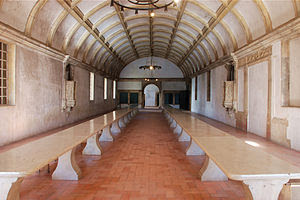Meals were taken in the main Frater (sometimes called Refectory). Monasteries were the only places during the Dark and Middle Ages which had a specific eating room. Separate dining rooms did not otherwise appear until the Renaissance villa in Italy. The monastic Frater was usually situated in the main cloister and opposite the church. Generally large and often impressive architecturally, it was an important place.
A surviving example is the former Frater of Worcester Cathedral Priory, now used as a hall for the King’s School. It is 120 long by 32 feet wide.
 |
| Interior of King's School Hall, Worcester(from Worcester Cathedral and Library Archive blog) |
 |
| Exterior of King's School Hall, Worcester (from Worcester Cathedral and Library Archive blog) |
 |
| Frater at Rievaulx today (above) and how it may have been (English Heritage) |
More often at ground level in Benedictine, in Cluniac and Cistercian houses there are examples of first floor level, possibly to emulate Christ’s upper room Last Supper.
 |
| Procession into dinner |
 |
| Lavatorium at Fountains (from Cistercians in Yorkshire Project) |
They would collect spoons and napkins as they entered and take their places facing inwards at the tables around the wall, leaving space behind them for the servers to supply the food. A monk would likely have his own knife, which he would carry with him. Spoons were more rare and at Westminster they were given out at each meal and collected afterwards. Forks were unknown in British monasteries. Knives, spoons and hands would be used as needed.
Grace would be said and then the reading would begin soon after the presider sat down. Silence was expected. The only exception might be if there were guests the presider might speak to them. Usually a passage was read from the Bible (in Latin) eg the four Books of Kings, Job or the Books of Maccabees. None these sound like an aid to digestion....Otherwise it might be a part of the life of a Saint. The reading was to be done slowly but distinctly, repeating any really important passage. Monks had to be quiet during the reading. Courses would follow swiftly one after the other. A bell might be used to have food taken away.
 |
| Refectory of Alcobaca Abbey in Portugal. Note the amazing reading gallery on left. Closeup below. From Motorhome Europe blog. |
 |
The ideal monastic meal was like a ritual and we can detect the first instances of table manners at the time. However, it is hard to believe that meals were always quiet or that the reader was audible, particularly as discipline was relaxed in the later Middle Ages.
 |
| Convent of Christ, Tomar, Portugal. Note table arrangement and pulpit |
We can get a picture of what went on by the rules which have been recorded. Bear in mind that these rules were not universal.
- Nuts were not to be cracked with teeth, but eased open with a knife. However if everyone had nuts they could go ahead and crack all together!
- Monks were to eat their food calmly, cleanly, cheerfully.
- They should not let their eyes wander.
- They should not sit chin in hand or put hands across the face.
- They should sit up straight and keep arms off the table.
- No wiping of knife on table cloth before wiping it on bread.
- No wiping of teeth on the tablecloth.
Generally food was blessed at the meal and leftovers could be given to other people - possibly lay brothers, or the poor who used to gather at the gate. Unblessed food went to dogs or pigs or other animals. After eating monks had to wash hands in the Lavatorium, waiting in the cloister until all had finished. They might then chant the Miserere (Ps 51) on the way to the Church and their next Office. Readers and servers then took their meal.
Guests of less importance might eat in the lay brother’s refectory, if there was one. A marshal would guard against pilfering, unruly behaviour and items thrown on the floor. Trestle tables would likely be set up after the guests sat down and then removed later.
Our eating arrangements here in St Albans had the Frater on the north side of the main cloister. I spent some time this summer trying to make out evidence of any outlines, because the unusually dry hot summer suggests the layout of the abbey.
 |
| Imagine monks lining up for dinner |
 |
| Cloister edge and Abbot's lodging off to the left against the nave wall. |



There is quite a lot of information on food and eating to be gleaned from a section of Custumale Rofense, a thirteenth-century custumal from St Andrew's Priory, Rochester; it's in the section on the servants. I should be publishing a translation of this online in due course via Rochester Cathedral's website. You might find it useful.
ReplyDelete